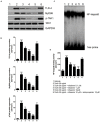Rifaximin Improves Clostridium difficile Toxin A-Induced Toxicity in Caco-2 Cells by the PXR-Dependent TLR4/MyD88/NF-κB Pathway
- PMID: 27242527
- PMCID: PMC4860461
- DOI: 10.3389/fphar.2016.00120
Rifaximin Improves Clostridium difficile Toxin A-Induced Toxicity in Caco-2 Cells by the PXR-Dependent TLR4/MyD88/NF-κB Pathway
Abstract
Background: Clostridium difficile infections (CDIs) caused by Clostridium difficile toxin A (TcdA) lead to severe ulceration, inflammation and bleeding of the colon, and are difficult to treat.
Aim: The study aimed to evaluate the effect of rifaximin on TcdA-induced apoptosis in intestinal epithelial cells and investigate the role of PXR in its mechanism of action.
Methods: Caco-2 cells were incubated with TcdA and treated with rifaximin (0.1-10 μM) with or without ketoconazole (10 μM). The transepithelial electrical resistance (TEER) and viability of the treated cells was determined. Also, the expression of zona occludens-1 (ZO-1), toll-like receptor 4 (TLR4), Bcl-2-associated X protein (Bax), transforming growth factor-β-activated kinase-1 (TAK1), myeloid differentiation factor 88 (MyD88), and nuclear factor-kappaB (NF-κB) was determined.
Results: Rifaximin treatment (0.1, 1.0, and 10 μM) caused a significant and concentration-dependent increase in the TEER of Caco-2 cells (360, 480, and 680% vs. TcdA treatment) 24 h after the treatment and improved their viability (61, 79, and 105%). Treatment also concentration-dependently decreased the expression of Bax protein (-29, -65, and -77%) and increased the expression of ZO-1 (25, 54, and 87%) and occludin (71, 114, and 262%) versus TcdA treatment. The expression of TLR4 (-33, -50, and -75%), MyD88 (-29, -60, and -81%) and TAK1 (-37, -63, and -79%) were also reduced with rifaximin versus TcdA treatment. Ketoconazole treatment inhibited these effects.
Conclusion: Rifaximin improved TcdA-induced toxicity in Caco-2 cells by the PXR-dependent TLR4/MyD88/NF-κB pathway mechanism, and may be useful in the treatment of CDIs.
Keywords: Caco-2 cells; Clostridium difficile toxin A; pregnane X receptor; pseudomembranous colitis; rifaximin.
Figures


Similar articles
-
Lathyrus sativus diamine oxidase reduces Clostridium difficile toxin A-induced toxicity in Caco-2 cells by rescuing RhoA-GTPase and inhibiting pp38-MAPK/NF-κB/HIF-1α activation.Phytother Res. 2021 Jan;35(1):415-423. doi: 10.1002/ptr.6814. Epub 2020 Sep 10. Phytother Res. 2021. PMID: 32914548
-
Wogonin suppresses inflammatory response and maintains intestinal barrier function via TLR4-MyD88-TAK1-mediated NF-κB pathway in vitro.Inflamm Res. 2015 Jun;64(6):423-31. doi: 10.1007/s00011-015-0822-0. Epub 2015 Apr 28. Inflamm Res. 2015. PMID: 25917044
-
Rifaximin, a non-absorbable antibiotic, inhibits the release of pro-angiogenic mediators in colon cancer cells through a pregnane X receptor-dependent pathway.Int J Oncol. 2016 Aug;49(2):639-45. doi: 10.3892/ijo.2016.3550. Epub 2016 Jun 1. Int J Oncol. 2016. PMID: 27279570
-
The xenobiotic sensing pregnane X receptor regulates tissue damage and inflammation triggered by C difficile toxins.FASEB J. 2020 Feb;34(2):2198-2212. doi: 10.1096/fj.201902083RR. Epub 2019 Dec 17. FASEB J. 2020. PMID: 31907988 Free PMC article.
-
Dexmedetomidine Resists Intestinal Ischemia-Reperfusion Injury by Inhibiting TLR4/MyD88/NF-κB Signaling.J Surg Res. 2021 Apr;260:350-358. doi: 10.1016/j.jss.2020.11.041. Epub 2020 Dec 28. J Surg Res. 2021. PMID: 33383282
Cited by
-
Dual therapy with zinc acetate and rifaximin prevents from ethanol-induced liver fibrosis by maintaining intestinal barrier integrity.World J Gastroenterol. 2021 Dec 28;27(48):8323-8342. doi: 10.3748/wjg.v27.i48.8323. World J Gastroenterol. 2021. PMID: 35068872 Free PMC article.
-
Exploring the roles of intestinal flora in enhanced recovery after surgery.iScience. 2023 Jan 13;26(2):105959. doi: 10.1016/j.isci.2023.105959. eCollection 2023 Feb 17. iScience. 2023. PMID: 36756379 Free PMC article. Review.
-
Prevention of Cirrhosis Complications: Looking for Potential Disease Modifying Agents.J Clin Med. 2021 Oct 5;10(19):4590. doi: 10.3390/jcm10194590. J Clin Med. 2021. PMID: 34640608 Free PMC article. Review.
-
Rifaximin Alleviates Endotoxemia with Decreased Serum Levels of Soluble CD163 and Mannose Receptor and Partial Modification of Gut Microbiota in Cirrhotic Patients.Antibiotics (Basel). 2020 Mar 29;9(4):145. doi: 10.3390/antibiotics9040145. Antibiotics (Basel). 2020. PMID: 32235367 Free PMC article.
-
Cannabidiol restores intestinal barrier dysfunction and inhibits the apoptotic process induced by Clostridium difficile toxin A in Caco-2 cells.United European Gastroenterol J. 2017 Dec;5(8):1108-1115. doi: 10.1177/2050640617698622. Epub 2017 Mar 13. United European Gastroenterol J. 2017. PMID: 29238589 Free PMC article.
References
-
- Cash B. D., Lacy B. E., Rao T., Earnest D. L. (2016). Rifaximin and eluxadoline – newly approved treatments for diarrhea-predominant irritable bowel syndrome: what is their role in clinical practice alongside alosetron? Expert Opin. Pharmacother. 17 311–322. 10.1517/14656566.2016.1118052 - DOI - PubMed
LinkOut - more resources
Full Text Sources
Other Literature Sources
Research Materials
Miscellaneous

